Liquid Synthetic Rubber Market Size
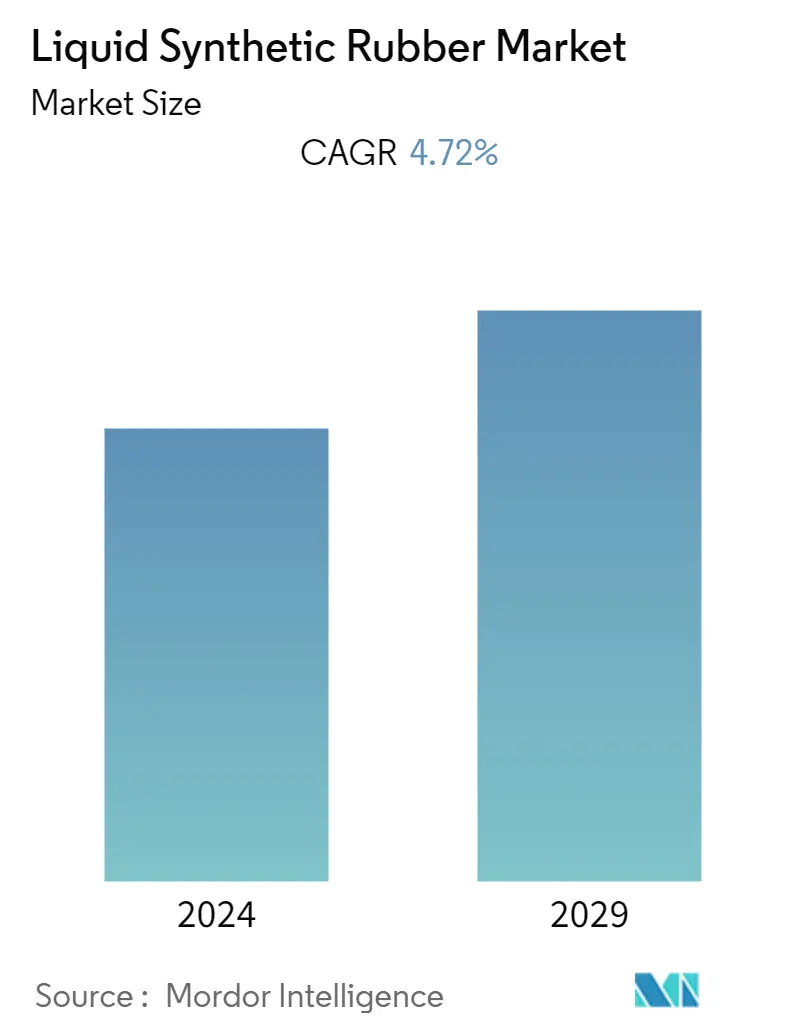
| Study Period | 2019 - 2029 |
| Base Year For Estimation | 2023 |
| CAGR | 4.72 % |
| Fastest Growing Market | Asia Pacific |
| Largest Market | Asia Pacific |
| Market Concentration | Low |
Major Players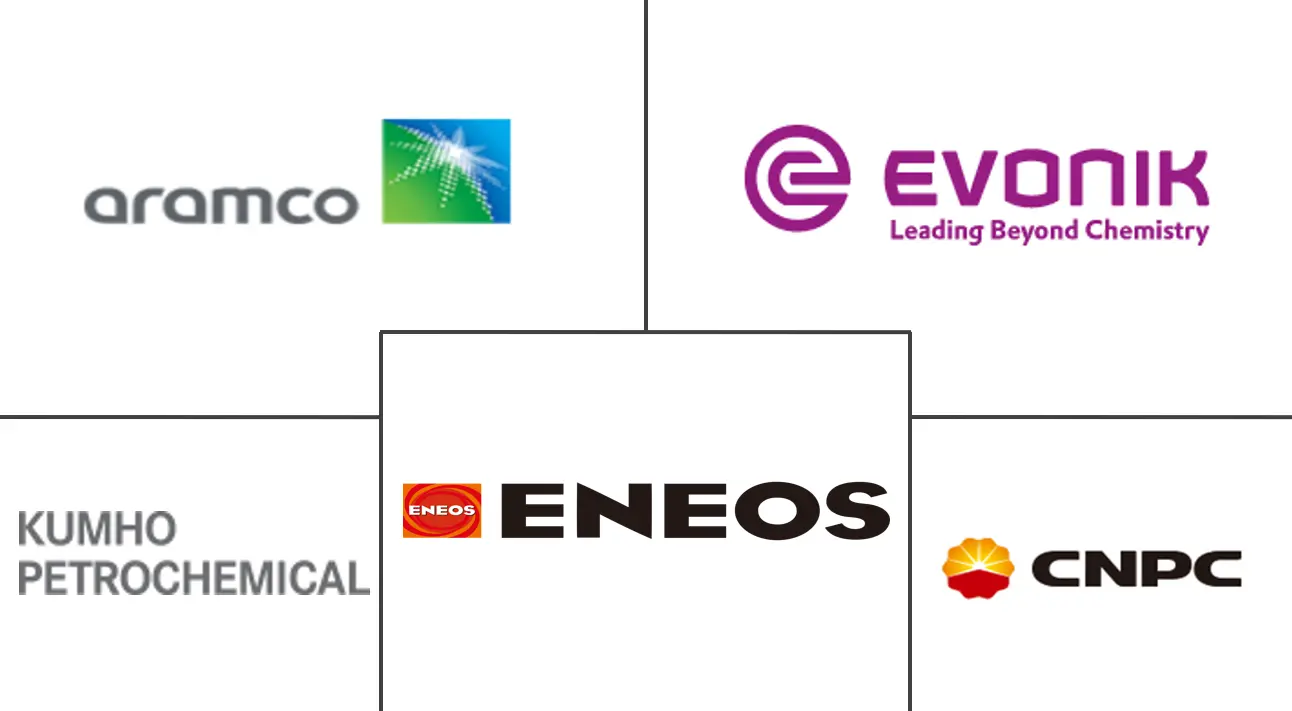
*Disclaimer: Major Players sorted in no particular order |
Need a report that reflects how COVID-19 has impacted this market and its growth?
Liquid Synthetic Rubber Market Analysis
The Global Liquid Synthetic Rubber Market size is expected to grow from USD 15.87 billion in 2023 to USD 19.99 billion by 2028, at a CAGR of 4.72% during the forecast period (2023-2028).
COVID-19 negatively impacted the market in 2020-2021. Considering the pandemic scenario, automotive manufacturing activities were temporarily stopped during the government-imposed lockdown to curb the spread of new COVID-19 cases, thereby reducing the demand for liquid synthetic rubber-based automotive parts such as tires, drive belts, seals, gaskets, hoses, tank linings, and others. However, the market is expected to regain its growth trajectory in 2023 and is likely to follow a similar trajectory during the forecast period.
- Over the short term, the rising demand from the adhesive segment is expected to drive the market's growth.
- On the flip side, fluctuating raw material prices are expected to hinder the market growth.
- Developing bio-based feedstock for synthetic rubber will likely act as an opportunity during the forecast period.
Liquid Synthetic Rubber Market Trends
Increasing Demand from the Tire Segment
- Liquid synthetic rubber has wide applications in the manufacturing of tires because it provides enhanced durability and superior performance, along with the adoption of tire labeling regulations.
- The primary product used in the manufacturing of tires is polybutadiene. It is primarily used as a sidewall in tires to improve fatigue caused by continuous flexing during the run. Besides, butadiene has various applications in other automobile parts.
- According to the US Tire Manufacturers Association, tires used in passenger and light trucks have 24% synthetic rubber by volume, and tires used in heavy trucks have 11% synthetic rubber by volume. Furthermore, around 50% of car tires are made of styrene-butadiene rubber, which blends with natural rubber.
- According to the International Tyre and Rubber Association (ITRA), China and the United States are the two largest tire-producing countries in the world. According to data from the General Administration of Customs of the PRC, 3.77 million tons of rubber tires were cumulatively exported from China in the first half of 2022, up 7.2% from the same period last year.
- The US Tire Manufacturers Association also stated that tires used in passenger and light trucks use 24% synthetic rubber (such as SBR), and heavy trucks use 11% synthetic rubber by volume.
- According to the Organisation Internationale Des Constructeurs d'Automobiles (OICA), in 2022, around 85.01 million vehicles were produced across the globe, witnessing a growth rate of 5.99% compared to 80.205 million vehicles in 2021, thereby indicating an increased demand for tires from the automotive industry. In 2022, around 60 million passenger cars were manufactured worldwide, up nearly 7.35% compared to 2021.
- However, in several Asian and European countries, production of tires has been witnessing a gradual yet consistent decline due to reduced demand in both the replacement and original equipment manufacturer (OEM) segments. For instance, the total tire production in India declined by 4% to 169.07 million in FY 2021-2022, compared to the previous year, as per the data released from ATMA.
- Overall, all the factors above have impacted tire production, which is further expected to affect the liquid synthetic rubber market.
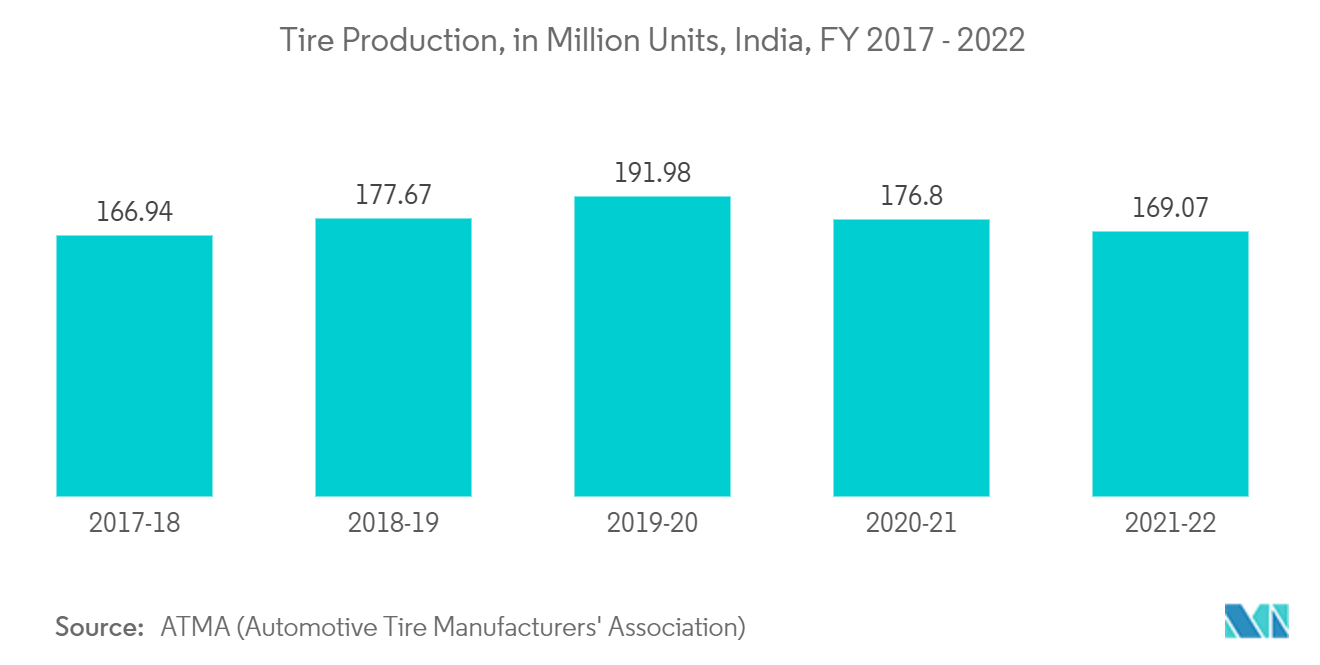
Asia-Pacific Region to Dominate the Market
- The Asia-Pacific region is expected to dominate the market for liquid synthetic rubber during the forecast period. In countries like China, India, and Japan, owing to the increasing demand from applications such as tire manufacturing, industrial rubber manufacturing, adhesives, sealants, coatings, and polymer modification.
- China is the largest producer and consumer of automotive vehicles. The China Association of Automobile Manufacturers reports that, compared to the prior year, China's automobile sales increased by about 2.1% in 2022. Compared to the 26.27 million automobiles sold in 2021, around 26.86 million were sold in 2022.
- Liquid synthetic rubber also finds application in the construction industry. According to the National Development and Reform Commission, the Chinese government approved 26 infrastructure projects at an estimated investment of about USD 142 billion, estimated to be completed by the end of 2023 and ongoing. The increase in the construction of tall buildings and hotels is driving the market study.
- India is the fourth-largest consumer of rubber in the world as of 2022. Rubber usage per capita in India is currently 1.2 kg, compared to 3.2 kg globally. India's rubber industry generates approximately INR 12,000 crore (USD 1.44 billion). The tire sector consumes most of India's rubber production, accounting for over half of the country's total output.
- The Indian rubber industry exhibits the co-existence of the rubber production sector and the fast-growing rubber product manufacturing and consumption sectors. Factors driving the rubber industry in the country include the positive intervention of institutional agencies that aim at self-sufficiency and import substitution.
- With the ever-increasing demand for tires, industrial rubber, adhesives, and sealants in the region and the expansion of production plants by several major players in the industry, the market for liquid synthetic rubber is also expected to grow steadily during the forecast period.
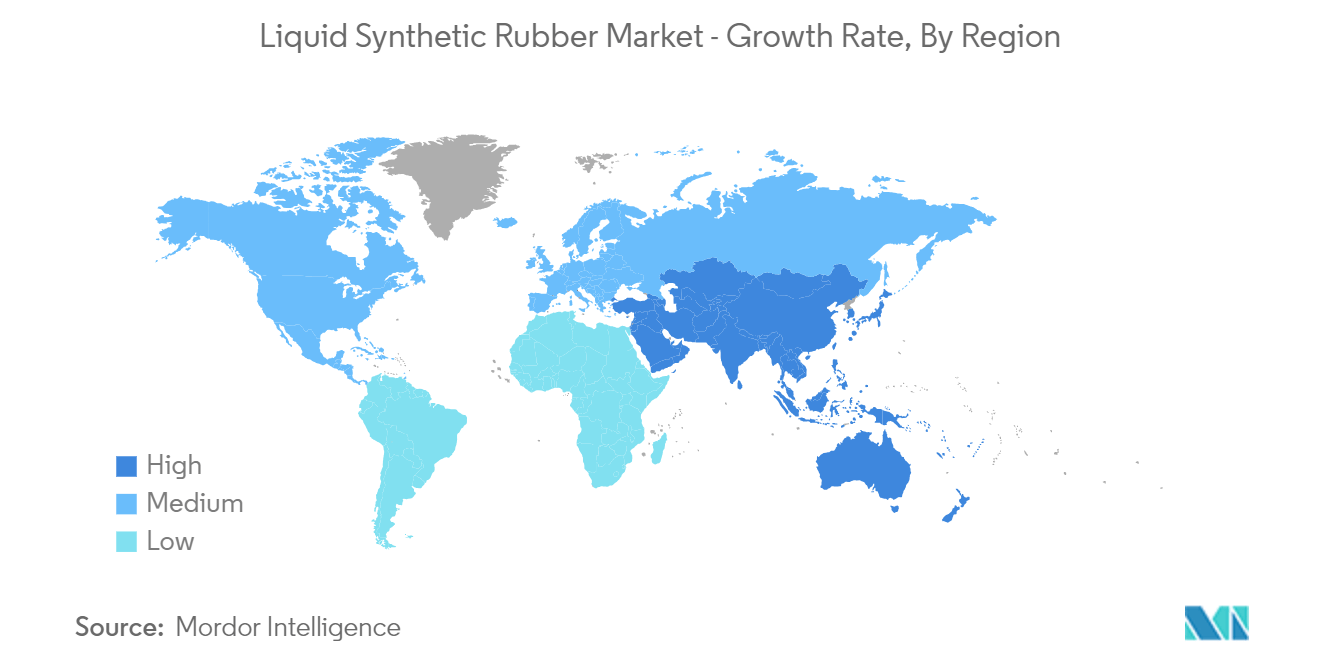
Liquid Synthetic Rubber Industry Overview
The liquid synthetic rubber market is fragmented in nature, with the presence of a wide range of players worldwide. Some of the players that maintain a significant share in the global market include (not in particular order) China National Petroleum Corporation, ENEOS Corporation, Evonik Industries AG, Kumho Petrochemical, and Saudi Arabian Oil Co. (Arlanxeo).
Liquid Synthetic Rubber Market Leaders
Evonik Industries AG
China National Petroleum Corporation
Kumho Petrochemical
ENEOS Corporation
Saudi Arabian Oil Co. (Arlanxeo)
*Disclaimer: Major Players sorted in no particular order
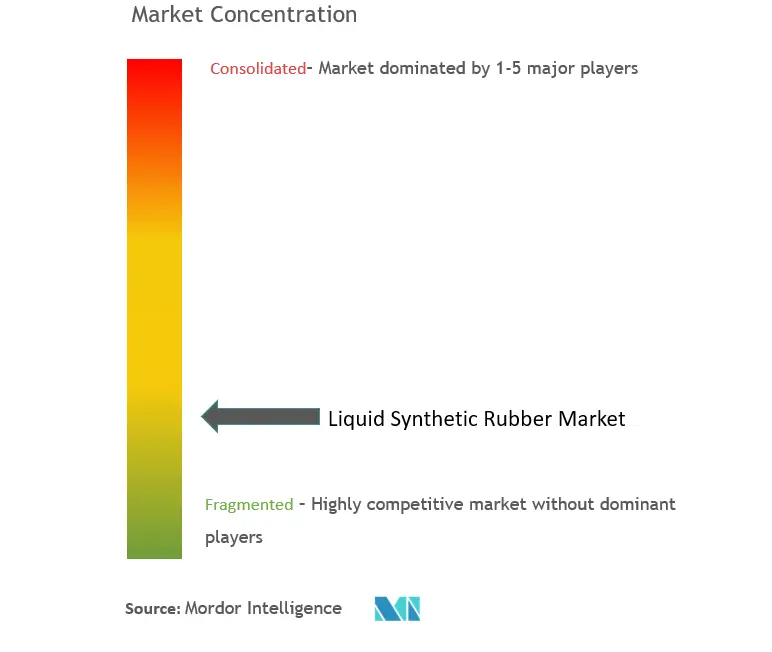
Liquid Synthetic Rubber Market News
- August 2022: Lion Elastomers announced the USD 22 million expansion of the Geismar plant. The expansion will increase production capacity at the plant, supporting the supply chains of automobile tire manufacturers and producing a broad range of other rubber goods. With the reinvestment in its Geismar plant, Lion Elastomers will retain 176 Capital Region jobs.
- March 2022: Arlanxeo, the Dutch-based synthetic rubber company, announced to increase in the annual production capacity of its EPDM synthetic rubber plant in Changzhou by 15%.
Liquid Synthetic Rubber Market Report - Table of Contents
1. INTRODUCTION
1.1 Study Assumptions
1.2 Scope of the Study
2. RESEARCH METHODOLOGY
3. EXECUTIVE SUMMARY
4. MARKET DYNAMICS
4.1 Drivers
4.1.1 Rising Demand from the Adhesive Segment
4.1.2 Growth in Tire Production Worldwide
4.2 Restraints
4.2.1 Fluctuating Raw Material Prices
4.3 Industry Value Chain Analysis
4.4 Porter's Five Forces Analysis
4.4.1 Bargaining Power of Suppliers
4.4.2 Bargaining Power of Consumers
4.4.3 Threat of New Entrants
4.4.4 Threat of Substitute Products and Services
4.4.5 Degree of Competition
5. MARKET SEGMENTATION (Market Size in Value)
5.1 Product Type
5.1.1 Liquid Isoprene
5.1.2 Liquid Butadiene
5.1.3 Liquid Styrene Butadiene
5.1.4 Other Product Types (Liquid EPDM and Liquid NBR)
5.2 Application
5.2.1 Adhesives
5.2.2 Industrial Rubber
5.2.3 Tire
5.2.4 Polymer Modification
5.2.5 Other Applications (Waterproofing Coatings and Footwear)
5.3 Geography
5.3.1 Asia-Pacific
5.3.1.1 China
5.3.1.2 India
5.3.1.3 Japan
5.3.1.4 South Korea
5.3.1.5 Rest of Asia-Pacific
5.3.2 North America
5.3.2.1 United States
5.3.2.2 Canada
5.3.2.3 Mexico
5.3.3 Europe
5.3.3.1 Germany
5.3.3.2 France
5.3.3.3 United Kingdom
5.3.3.4 Italy
5.3.3.5 Rest of Europe
5.3.4 South America
5.3.4.1 Brazil
5.3.4.2 Argentina
5.3.4.3 Rest of South America
5.3.5 Middle-East and Africa
5.3.5.1 Saudi Arabia
5.3.5.2 South Africa
5.3.5.3 Rest of Middle-East and Africa
6. COMPETITIVE LANDSCAPE
6.1 Mergers and Acquisitions, Joint Ventures, Collaborations, and Agreements
6.2 Market Ranking Analysis
6.3 Strategies Adopted by Leading Players
6.4 Company Profiles
6.4.1 Asahi Kasei Advance Corporation
6.4.2 China National Petroleum Corporation
6.4.3 ENEOS Corporation
6.4.4 Evonik Industries AG
6.4.5 H.B. Fuller Company
6.4.6 KUMHO PETROCHEMICAL
6.4.7 Kuraray Co. Ltd
6.4.8 Linshi Chem (Puyang) Advanced Material Co. Ltd.
6.4.9 Lion Elastomers
6.4.10 NIPPON SODA CO. LTD.
6.4.11 Saudi Arabian Oil Co. (Arlanxeo)
6.4.12 SIBUR Holding PJSC
6.4.13 Synthomer PLC
6.4.14 TER Group
- *List Not Exhaustive
7. MARKET OPPORTUNITIES AND FUTURE TRENDS
7.1 Development of Bio-based Feedstock for Synthetic Rubber
Liquid Synthetic Rubber Industry Segmentation
Liquid synthetic rubber is a low-molecular-weight liquid polymer of synthetic rubber, mainly used in the production of tires and to improve the adhesive and polymer properties. Even at low temperatures, it offers good adhesion and improved coating and flow properties. The liquid synthetic rubber market is segmented by product type, application, and geography (Asia-Pacific, North America, Europe, South America, the Middle East, and Africa). By product type, the market is segmented into liquid isoprene, liquid butadiene, liquid styrene-butadiene, and other product types. By application, the market is segmented into adhesives, industrial rubber, tires, polymer modification, and other applications. The report also covers the market size and forecasts for the liquid synthetic rubber market in 15 countries across major regions. For each segment, market sizing and forecasts have been done based on revenue (USD).
| Product Type | |
| Liquid Isoprene | |
| Liquid Butadiene | |
| Liquid Styrene Butadiene | |
| Other Product Types (Liquid EPDM and Liquid NBR) |
| Application | |
| Adhesives | |
| Industrial Rubber | |
| Tire | |
| Polymer Modification | |
| Other Applications (Waterproofing Coatings and Footwear) |
| Geography | |||||||
| |||||||
| |||||||
| |||||||
| |||||||
|
Liquid Synthetic Rubber Market Research FAQs
What is the current Liquid Synthetic Rubber Market size?
The Liquid Synthetic Rubber Market is projected to register a CAGR of 4.72% during the forecast period (2024-2029)
Who are the key players in Liquid Synthetic Rubber Market?
Evonik Industries AG, China National Petroleum Corporation, Kumho Petrochemical, ENEOS Corporation and Saudi Arabian Oil Co. (Arlanxeo) are the major companies operating in the Liquid Synthetic Rubber Market.
Which is the fastest growing region in Liquid Synthetic Rubber Market?
Asia Pacific is estimated to grow at the highest CAGR over the forecast period (2024-2029).
Which region has the biggest share in Liquid Synthetic Rubber Market?
In 2024, the Asia Pacific accounts for the largest market share in Liquid Synthetic Rubber Market.
What years does this Liquid Synthetic Rubber Market cover?
The report covers the Liquid Synthetic Rubber Market historical market size for years: 2019, 2020, 2021, 2022 and 2023. The report also forecasts the Liquid Synthetic Rubber Market size for years: 2024, 2025, 2026, 2027, 2028 and 2029.
Liquid Synthetic Rubber Industry Report
Statistics for the 2024 Liquid Synthetic Rubber market share, size and revenue growth rate, created by Mordor Intelligence™ Industry Reports. Liquid Synthetic Rubber analysis includes a market forecast outlook 2029 and historical overview. Get a sample of this industry analysis as a free report PDF download.
